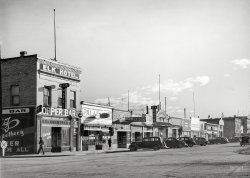
MAY CONTAIN NUTS

Search Shorpy
SHORPY ART

Framed or unframed, desk size to sofa size, printed by us in Arizona and Alabama since 2007. Explore now.
Join and Share
Ad-Free Shorpy
Shorpy is funded by you. Patreon contributors get an ad-free experience.
Learn more.

Recent comments
- Baldwin 62303
- Baldwin VO-1000
- Cold
- No expense spared
- Tough Guys
- Lost in Toyland
- And without gloves
- If I were a blindfolded time traveler
- Smoke Consumer Also Cooks
- Oh that stove!
- Possibly still there?
- What?!?
- $100 Reward
- Freeze Frame
- Texas Flyer wanted
- Just a Year Too Soon
- WWII -- Replacing men with women at the railroad crossing.
- Yes, Icing
- You kids drive me nuts!
- NOT An Easy Job
- I wonder
- Just add window boxes
- Icing Platform?
- Indiana Harbor Belt abides
- Freezing haze
- Corrections (for those who care)
- C&NW at Nelson
- Fallen Flags
- A dangerous job made worse
- Water Stop
Member Photos
The Shorpy
Print Emporium
Print Emporium
Search Shorpy
Search results -- 30 results per page
- Ducktown Scab Committee: 1939
- ... 35mm nitrate negative by Marion Post Wolcott for the Farm Security Administration.
Scab Committee So Mr. Right has his cudgel and ... Posted by Dave - 05/24/2008 - 1:31pm -
![Ducktown Scab Committee: 1939 October 1939. "Picketing. Copper miners on strike waiting for scabs to come out of the mines. Ducktown, Tennessee." View full size. 35mm nitrate negative by Marion Post Wolcott for the Farm Security Administration.
Scab CommitteeSo Mr. Right has his cudgel and Middle Boy is holding a rock or brick. Can't wait to see what happens!
Rock Or Harmonica?To me the rock looks like a harmonica and the cudgel could be a walking stick because of a mine accident but then I am a 100% Union man and my view may be clouded.
[Rock. - Dave]
Scab CommitteeMy grandfather, John McGee, worked as a supervisor and demolitions expert in the Burra Burra mines in Ducktown, and I was just visiting family there. Folk in town say that this wasn't a scab committee, and these men weren't holding weapons.
Instead, they were sitting around Main Street, whittling (note the carved end of the stick). This was a very common practice in those days; the men usually gathered on street corners, either in front of the hotel or the company store, just to talk and pass the time.
The first gentleman is Wesley Davis, the young man in the middle is Everette Goode and the third man is Tom Mealer. I saw Everette Goode during my visit (and yes, he was wearing overalls).
A version of this photo is featured in this year's Copper Basin Pictorial Calendar from the Ducktown Basin museum; these gentlemen are the September feature.
BTW, my grandfather was a part of that strike; in fact, he was put in jail by the mining company on suspicion of blowing up the power lines to the mines. But they couldn't prove anything, so he was released.
I want to thank David Beckler for his help on this; he lives two doors down from the old Ducktown Hotel on Main Street where this picture was taken.
Delia
Ducktown MinersHi Delia,
I visited the mine museum yesterday (Nov. 8) and looked at that same calendar page, but it indicated that the man on the left was Bert Hensley. Here's a current photo of the corner where they were sitting:
(The Gallery, M.P. Wolcott, Mining)](https://www.shorpy.com/files/images/8a40873u.thumbnail.jpg)
- Snow Depot: 1940
- ... format acetate negative by Marion Post Wolcott for the Farm Security Administration. View full size.
Enduring Depot This station ... Posted by Dave - 06/01/2019 - 11:52am -
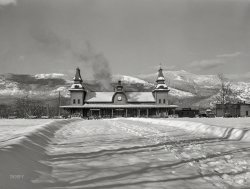
- Carson City: 1940
- ... Carson City, Nevada." Photo by Arthur Rothstein for the Farm Security Administration. View full size.
Oh yes, it's possible ... Posted by Dave - 02/24/2018 - 7:20pm -
![Carson City: 1940 March 1940. "Operating switch at railroad station. Carson City, Nevada." Photo by Arthur Rothstein for the Farm Security Administration. View full size.
Oh yes, it's possibleThis car probably goes into Mexico and back, so liters=litros
Target practice.Looks like the day marker was used as a target on one or more occasions.
Stub SwitchStraight up Straight ahead.
Is it possible ...that oil tank car is measured in both litres and gallons??
[Capacidad 40436 litros (liters) does indeed = 10862 gallons. -tterrace]
Virginia & TruckeeNice view of a stub switch, not uncommon on narrow gauge railroads, but V&T was standard gauge. That's V&T locomotive #26, a 1907 Baldwin 4-6-0. She was destroyed in an engine house fire in 1950.
Voyage à TroisNever seen a three-way track switch before. That's some clever engineering.
A modern 3-way stub switchActually it is no more complicated to layout a three-way stub than it is to lay out a single switch--just twice as much work. You basically work off of a set of tables in a a book.
Stub switches are no longer legal on interchange railroads in the USA. They are not as safe as a 'knife' switch because a train going through a switch set incorrectly will derail and drop the lead cars onto the ties. (an experience I do not want to repeat!)
Here is an example of a modern 3-way stub located at the Railroad Museum at Ardenwood, in Fremont, CA on a 3 ft gauge railroad. The switch stand is a harp stand located just out of the picture on the left (you can see the target),
(The Gallery, Arthur Rothstein, Railroads, Small Towns)](https://www.shorpy.com/files/images/SHORPY-8b19825a.thumbnail.jpg)
- Llano de San Juan: 1940
- ... full size. 4x5 Kodachrome transparency by Russell Lee, Farm Security Administration.
Llano de San Juan There is an interior ... Posted by Dave - 08/30/2012 - 2:01pm -
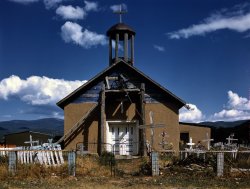
- Clark's Corner: 1937
- ... "Roadstand near Cocoa." Photo by Arthur Rothstein for the Farm Security Administration. View full size.
Cocoa Beach! Just wait ... Posted by Dave - 02/13/2014 - 5:47pm -
![Clark's Corner: 1937 January 1937. Brevard County, Florida. "Roadstand near Cocoa." Photo by Arthur Rothstein for the Farm Security Administration. View full size.
Cocoa Beach!Just wait another thirty years, give or take. A bottle will wash up on the shore, to be discovered by an astronaut on a training exercise.
[No bottles will be washing up in Cocoa, which is on the Indian River and about 8 miles from Cocoa Beach and the Atlantic Ocean. - Ken]
Pop. 120As described in Florida: A Guide to the Southernmost State (Federal Writers' Project, 1939):
"INDIAN RIVER CITY, 50.9m (19 alt., 120 pop.) formerly called Clark's Corner, consists of a few stucco houses, filling stations, and a post office, overlooking the broad reaches of the river. Indian River City is at the junction with State 22 (see Tour 9).
South of Indian River City dense growths of palms and pines flank U.S. 1; palmetto thickets and low green shrubbery add to the beauty of the water views."
In Color!Corner of (now) SR50 and US1. Postcard from the State Archives of Florida, (Florida Memory).
I HAD to look it upa TEMPLE is a bright orange red colored fruit, oval shaped, easy to peel and a cross between an orange and a tangerine, it has lots of seeds and a bitter orange flesh under the skin.
TitusvilleThis stand was about 20 minutes away from Cocoa and 30 miles from Cocoa Beach. The corner is in Titusville (I live within walking distance of it). Indian River City was consolidated with Titusville back in the 60's. Today if you look across that river you can see Kennedy Space Center. There is nothing left of the buildings in the post card. It's now a busy intersection with a Walgreens and a gas station.
The temple orangeThe temple orange originated in Winter Park Florida, developed by Louis Hakes and named after W. C. Temple, both residents of Winter Park. There's a Temple Drive and Temple Trail in Winter Park, the latter leading into the neighborhood in which I grew up.
(The Gallery, Arthur Rothstein, Eateries & Bars, Florida, Stores & Markets)](https://www.shorpy.com/files/images/SHORPY_8b28486a.thumbnail.jpg)
- Saddle Straddler: 1940
- ... Medium format acetate negative by Arthur Rothstein for the Farm Security Administration. View full size.
Cardboard cowboy The ... Posted by Dave - 06/24/2019 - 1:19pm -
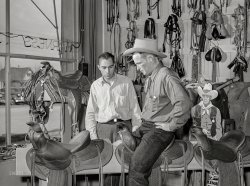
- Weldon Drake: 1942
- ... yesterday's posts playing with his father and brother at a Farm Security Administration Saturday-night dance. View full size.
Twelve ... Posted by Dave - 07/30/2012 - 10:49am -
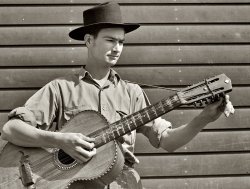
- Welcome to Woodville: 1941
- ... Medium format acetate negative by Jack Delano for the Farm Security Administration. View full size.
Georgia Irish The Gaelic ... Posted by Dave - 07/09/2021 - 10:22pm -
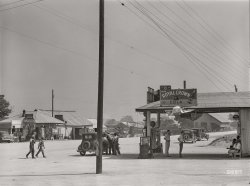
- Big Brother: 1935
- ... Plantation, Arkansas. October 1935. View full size. Farm Security Administration photograph by Ben Shahn.
What beautiful children! ... Posted by Dave - 09/07/2011 - 7:47pm -
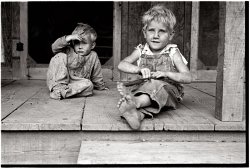
- Jim and Wife: Pie Town, 1940
- ... This is one of hundreds of pictures taken in Pie Town by Farm Security Administration photographer Russell Lee in 1940.
This Pie Town ... Posted by Dave - 12/14/2007 - 1:52am -
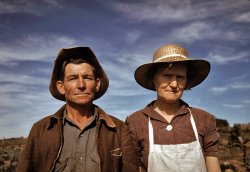
- Silverton: 1940
- ... be seen at right." Acetate negative by Russell Lee for the Farm Security Administration. View full size.
I've always wondered ... Posted by Dave - 11/27/2020 - 2:32pm -
![Silverton: 1940 September 1940. "Silverton, Colorado, lies in a valley at 9,400 feet elevation. This has been a center for mining and milling operations, and the tailing-choked Animas River can be seen at right." Acetate negative by Russell Lee for the Farm Security Administration. View full size.
I've always wonderedDo kids growing up in a place like this walk up those mountains just for the fun of it or do they just ignore them? Because when I was a kid I'd have definitely felt like doing it.
View in 2009Shot this on my way out of town, a tourist shot. I think you can see the building with the tower in the 1940 view toward the right side of mine, minus its tower I think.
Picture qualityStreetview has the almost the same point of view, taken from Highway 550, back in December of 2007, but the resolution is an insult to our eyes after having seen this excellent photo.
Plus 70-some yearsBoth much the same, and changed in a thousand ways.
Hillside CemeteryWhat's that black line up near where the hillside cemetery is?
[A scratch in the emulsion. - Dave]
My Silverton pic: 2018In August of 2018 while on vacation, I drove up to Silverton & saw this view & had to take a picture. I did not expect to see an 80-year-old picture 2 years later. What a great comparison.
(The Gallery, Frontier Life, Landscapes, Mining, Russell Lee, Small Towns)](https://www.shorpy.com/files/images/SHORPY-8b26301a.thumbnail.jpg)
- Slick Depot: 1940
- ... Medium format acetate negative by Russell Lee for the Farm Security Administration. View full size.
Okie names Well, I thought ... Posted by Dave - 07/18/2018 - 1:44pm -
![Slick Depot: 1940 February 1940. "Abandoned railway station, now used as a church, in the oil ghost town of Slick, Oklahoma." Medium format acetate negative by Russell Lee for the Farm Security Administration. View full size.
Okie namesWell, I thought I had heard them all but that's a new one! I know of Gotebo and Bug Tussle (I had to check the spelling here) and I once lived near Fanshawe and Red Oak. The last two were just "blink and you miss them" spots 20 years ago.
[Named for oilman Thomas B. Slick. - Dave]
The building today!
Still there- - still a church, still slick.
Fire and brimstoneIt appears that the Reverend went a little heavy on the fire part, enough to buckle the right side of the roof and bow the guttering, which by the way, needs another downspout on that deformed section.
Nice punSlick seems like the perfect name for an oil town.
... but why is there a "DANGEROUS" sign beside the church on the road?
[It's one of the danger signs of whatever. - Dave]
Full stopCareful, Tom Slick. Watch that dangerous Slick spot as you zoom by in your Thunderbolt Grease Slapper.
Oklahoma-SouthwesternEdson says the Oklahoma-Southwestern Railway was active from 1920 to 1930; Moody's says it was dismantled in January 1930. Ran 24 miles southeast from the Frisco main at Bristow to a dead end at Nuyaka. T.B. Slick was president.
Amazing GraceMaybe she's a descendant of the town's namesake?
(The Gallery, Railroads, Russell Lee, Small Towns)](https://www.shorpy.com/files/images/SHORPY-8b23847a.thumbnail.jpg)
- Election Year: 1940
- May 1940. "Young Negro farm laborer. Stem, North Carolina." View full size. 35mm nitrate negative by Jack Delano for the Farm Security Administration.
J. Melville Broughton The campaign poster is for ... Posted by Dave - 01/01/2008 - 1:51am -
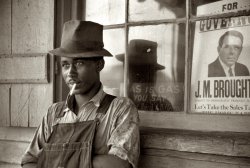
- Going to Town: 1940
- ... format acetate negative by Marion Post Wolcott for the Farm Security Administration. View full size.
River Street What a lovely ... Posted by Dave - 05/13/2019 - 9:38pm -
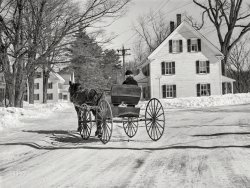
- Expert Lubrication: 1939
- ... Texas." Medium format negative by Russell Lee for the Farm Security Administration. View full size.
Cans Along the Border This ... Posted by Dave - 11/17/2017 - 11:36am -
![Expert Lubrication: 1939 February 1939. "Service station in Harlingen, Texas." Medium format negative by Russell Lee for the Farm Security Administration. View full size.
Cans Along the BorderThis is the service station of Lonnie Wade Molder (1911-1993), the son of Abraham Molder and Pearl Adair. Lonnie graduated from Harlingen High School in 1928, and then Brownsville Junior College in 1930. He married Edna Faye Swisher in 1935, and they had four children. It appears that he owned this station based on Harlingen city directory entries from 1944 to 1948.
Of interest in the photo is the array of oil cans that are the border to the shrubs at both the left and right of the photo as well as the change in gas price, from 16 to 15 cents, as seen on the sign on the canopy above the pumps. All of the planters, including the ones attached to the windows, appear to be reutilized gas tanks. A clearer view of the "Won Up" soda sign is below.
The Chevrolet pickup truck is a 1937 model and cost $515. This was the first year for the all steel cab (no wood). Based on the license plate, I believe this photo is actually from 1938 (the 1939 - 1941 commercial plates had "Texas" at the top). The enlarged license plate is also below.
Molder continued to own and operate the station into at least 1948. By 1950 he was a partner in North Side Welding & Repair down the street at 622 Commerce. By 1956 he had become the assistant manager for the service station at Harlingen Air Force Base (now Valley International Airport). He eventually went back to welding, and he was employed with Gulf Welding Supply in Harlingen for many years.
It appears that he retired in 1975. He and his wife then moved to LaFeria, Texas, in 1979, and by 1992 they were living in Ingram. He died the next year, Edna in 2006. From her obituary we learn that they met while she was still in grade school at South Ward School (now Bowie Elementary). Since he was seven years older, they would not have attended school together for any long period of time.
Molder's obituary mentions his involvement in the Masonic Lodge of both Harlingen and LaFeria. He served as the secretary for the Harlingen lodge for 35 years, he was a 32nd Degree Mason, and he received their Golden Trowel award in 1991.
Try that todayTexaco and Shell pumps at the same station!
Competing Brands?This is the first gas station I've ever seen with pumps for at least two different brands of gas, and the third pump seems to be unmarked. Was this common before WWII?
[For more buffet-style gas, click the links below. - Dave]
https://www.shorpy.com/node/4287
https://www.shorpy.com/node/20712
Flowers by FordI believe that the planter on the ground at center is made from a Model T gas tank.
Who dropped the ball?Unless my vision is failing me, this is one of the first pictures of a service station, convenience store or street scene that does not have an advertising sign for Coca-Cola, although I do see that the 7 Up rep and some other unknown beverage did get advertising signs as did the telephone company that is also a fixture in most old Shorpy photos of this nature.
[No Coke. Pepsi! - Dave]
An original "pumping gas story"During WWII, my uncle in Vinita, Oklahoma, owned a wholesale gasoline business. He had a 750-gallon tanker truck and would deliver to nearby country gas stations and to farms that had their own small storage tanks. My cousin and I, both 10 years old, would ride along to add interest to our lazy summer. In those days, there were two grades of gas, Ethyl and Regular. At one stop, he made the error of filling the Ethyl underground tank with Regular. In a hurry, he left the two of us to hand pump the Regular into the glass bowl and then drain it into the Regular tank. Ten gallons at a time. When he returned, both of us kids were really worn out. An aside: all gas was rationed. Civilians had 3 classes: A, B, and C. I think for 4, 8, and 12 gallons per week. Then there were commercial and farming classes based on need.
(The Gallery, Cars, Trucks, Buses, Gas Stations, Russell Lee)](https://www.shorpy.com/files/images/SHORPY-8b37234a.thumbnail.jpg)
- Fairest of Them All: 1941
- March 1941. "Mother and child. Bedford County farm, Virginia." Medium format acetate negative by John Vachon for the Farm Security Administration. View full size.
Bobby Pin Bobby pins used ... Posted by Dave - 01/24/2020 - 1:37pm -
![Fairest of Them All: 1941 March 1941. "Mother and child. Bedford County farm, Virginia." Medium format acetate negative by John Vachon for the Farm Security Administration. View full size.
Bobby PinBobby pins used to be everywhere. They were great if dangerous projectiles to shoot from a rubber-band powered hand-slingshot, making a satisfying whistling bullet noise.
Reflection of LifeJohn Vachon was a master with his camera. Catching the baby's face, plus mom's in the mirror is not an effortless task - especially keeping himself out of the picture. On another note, today's generation would consider the living conditions depicted here as "squalor" but was the norm for many of our ancestors who didn't give it much thought and were happy nonetheless. Sadly, I know some people today who could call CPS to report the conditions in which this child was living. Too much is taken for granted these days.
The look of love.A lovely, timeless photo. I'm suddenly thinking of my own mother, with tenderness. I hope you're thinking of yours.
Picture framesMy mom had five silver picture frames on the top of her bureau, the same size as those two with the man and the woman. The frames contained photos of her five children as little ones, and she had to polish the five frames about once a year, with Silvo and a rag, which she didn’t seem to mind. Also on the same bureau top was a silver set of brush and comb and mirror, with tortoiseshell trim.
StovepipeIs that a big stove pipe behind mom's face? Is the stove in the middle of the room? It just looks very strange to my eyes today in 2020.
[It's a stove ducted through a closed-up fireplace. -Dave]
(The Gallery, John Vachon, Kids)](https://www.shorpy.com/files/images/SHORPY-8c19250a.thumbnail.jpg)
- Less Filling: 1939
- ... Medium format acetate negative by Russell Lee for the Farm Security Administration. View full size.
12 Cents Sounds Good ... Posted by Dave - 03/20/2018 - 9:04pm -
![Less Filling: 1939 April 1939. "Service station. San Augustine, Texas." Medium format acetate negative by Russell Lee for the Farm Security Administration. View full size.
12 Cents Sounds Good...until you put it in an inflation calculator. It winds up being $2.11--about what we would pay now! At least we don't have to worry about patching our tubes any more, though.
Pump it upThere was a time that motorists or station attendants had to grab hold of a lever and literally pump up the fuel before filling the gas tank. However, despite changes at service stations with modern gasoline dispensers that don't use the old levers they are still referred to today as "gas pumps."
[Because that's still what they do -- pump gas up out of an underground tank. - Dave]
Drink **** ****is there anywhere in the United States where there isn't a Coca-Cola sign?
Gotta Love Hot PatchingMy dad taught me how to do this sort of patching a punctured tire, though it may differ from what's being sold here. To patch the inside or a tire or outside of a tube you first roughed up the rubber with a coarse perforated file, much like a cheese grater. Then you applied a coat of tire patch cement, which contains considerable volatile solvents. Then you lit the solvent and allowed it to burn for about 15-20 seconds... this had the effect of making the cement far more sticky and also slightly melting the top layer of the rubber tube/tire. Then you removed the backing from the patch, applied it to the puncture, and used a roller, or the edge of the can of patches, to press down the patch into the repair. It worked amazingly well and I don't recall ever having to re-do one.
Bicycle Tube Vulcanisers In Australia in the 1950s and 60s we patched our bicycle inner tubes with a Dunlop Vulcaniser. A patch was placed on the hole in the tube, and held in place with a clamp device. A small circular disc with a layer of a catalyst was placed in the clamp, and this was ignited. The heat, with attendant smoke, welded the patch to the tube. In a few minutes it cooled, and you were on your way again. No waiting for glue to dry. You can see a sample here.
Now That's How You Splice WiresGotta love the wiring for the overhead light and pumps. Perhaps a little bit of electrical larceny going on there?
Shorted wiring?At the end of the pump shed is a cross tree with two wires on it. It looks like the wire on the right has been shorted and the insulation is starting to melt off. Not surprising when you see an indoor socket hanging out in the open just to the right of the roof.
Different kind of hot patchingThe brand of hot patch being referred to here is Shaler, which was a self-vulcanizing type of patch similar to the ubiquitous "Monkey Grip sizzle patches" of bygone days. They used a rubber patch attached to the back side of a thin metal clamp-on tray of combustible chemicals to melt/vulcanize the rubber patch to the tube or tire, unlike the modern hot patches that just rely on burning off solvent to heat up and soften a rubber surface to promote adhesion.
Although not sold directly in the US any more, real self-vulcanizing patches are still made in and available from China and India.
(The Gallery, Gas Stations, Russell Lee, Small Towns)](https://www.shorpy.com/files/images/SHORPY-8b21592a.thumbnail.jpg)
- Chill Out: 1940
- ... Medium format acetate negative by John Vachon for the Farm Security Administration. View full size.
Looks like the Siege of ... Posted by Dave - 12/17/2019 - 10:27am -
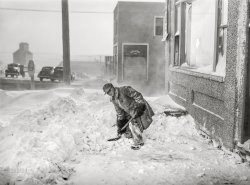
- War Chef: 1941
- ... View full size.
Keeping up with Collier Farm Security Administration photographer (and visual anthropologist) John Collier ... Posted by Dave - 12/03/2012 - 7:42pm -
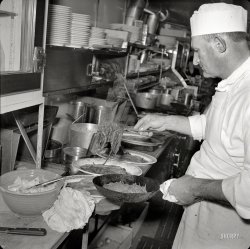
- Embraceable Ewe: 1936
- ... Medium format nitrate negative by Arthur Rothstein for the Farm Security Administration.
Baaaad If I didn't know better, I'd swear that ... Posted by Dave - 02/09/2008 - 4:54am -
![Embraceable Ewe: 1936 May 1936. "Farmer of Franklin County, Kansas." View full size. Medium format nitrate negative by Arthur Rothstein for the Farm Security Administration.
BaaaadIf I didn't know better, I'd swear that lamb is smiling!
Caption GOLD!That lamb probably IS smiling because your caption is HI-larious. Well done! Extra oats for you tonight.
Your Entertaining CaptionsI am a regular visitor to Shorpy and I must say some of your captions are quite entertaining and are almost as much fun to read as it is to view the photographs! Keep up the great work you are doing with this most entertaining, educational and fascinating blog.
[I think we are talking about the titles, not the captions. In any case, thank you! - Dave]
Right!Titles, right, of course. You work your magic on both, to be sure...a veritable Titlesmith & Caption Craftsman.
(A.T. put it best..."keep up the great work you are doing!")
(The Gallery, Animals, Arthur Rothstein, Rural America)](https://www.shorpy.com/files/images/8b27586u_0.thumbnail.jpg)
- The Far Horizon: 1940
- ... Medium format acetate negative by John Vachon for the Farm Security Administration. View full size.
I would not have guessed Iowa ... Posted by Dave - 06/18/2020 - 12:42pm -
![The Far Horizon: 1940 May 1940. "County road in Western Iowa corn country. Monona County." Medium format acetate negative by John Vachon for the Farm Security Administration. View full size.
I would not have guessed IowaI have driven around Iowa a fair bit, and don't remember rolling hills like these. Apparently, I learned something today.
Iowa's Loess Hillshttps://en.wikipedia.org/wiki/Loess_Hills
Only one or two other places on Earth have this geological formation of windswept river silt from the passing of the last Ice Age. Hills that are 100-300 feet tall that formed along the banks of the Missouri River valley in Western Iowa. China is the other place on Earth with such formations. If you drive through this area in any season it's pretty cool. Great hiking too.
IowaI am from Iowa and the one thing it is not is flat. The amount of hills though depend on where you are at in the state.
I would be willing to be that that road is still gravel. Iowa roads are set on a grid pattern to make getting crops to market easier. It means though most of them are gravel because farm equipment doesn't care if its on pavement or gravel.
Second shotIt seems Vachon appreciated the beauty of the sky that day and framed his image as a vertical. My photographer's guess is he also made an horizontal image that would give us an even better feel for a non-flat Iowa.
[His only other shot was another vertical. - Dave]
(The Gallery, Agriculture, John Vachon, Landscapes)](https://www.shorpy.com/files/images/SHORPY-8c17323a.thumbnail.jpg)
- Maryland Junk: 1937
- ... 4x5 inch acetate negative by Arthur Rothstein for the Farm Security Administration. View full size.
Important Anniversary Note ... Posted by Dave - 11/01/2017 - 10:54am -
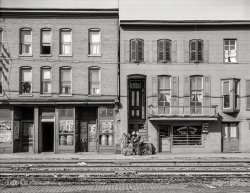
- Seedsto Day: 1939
- ... gin shed. Mound Bayou, Mississippi." Photo by Russell Lee, Farm Security Administration. View full size.
The Presleys of Mississippi ... Posted by Dave - 10/22/2013 - 12:42pm -
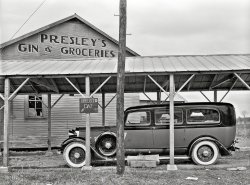
- Nathan, Sleepy and Weldon: 1942
- ... family entertaining at a Saturday night dance for the Farm Security Administration's resettlement camp at Weslaco, Texas, home to many ... Posted by Dave - 08/10/2012 - 4:56pm -
![Nathan, Sleepy and Weldon: 1942 From February 1942, another of Arthur Rothstein's photos of the Drake family entertaining at a Saturday night dance for the Farm Security Administration's resettlement camp at Weslaco, Texas, home to many farm families displaced by the droughts and bankruptcies of the Dust Bowl years. The fiddle player is Nathan Drake; on banjo and guitar are his sons Jasper ("Sleepy") and Weldon. Thanks to Jasper's daughters Connie and Janette for providing the names. View full size. (I'm having a Shorpy family moment here, having heard from the photographer's daughter, Annie Rothstein-Segan, and now Jasper's daughters. Life is a circle.)
Drake familyThis photo is in the book "Picturing Texas." It's the only one we thought existed. I am sure Annie is having a blast seeing all the pictures her Dad took! Thanks to him we all have just a few more memories!
[Yes, we owe Arthur Rothstein a lot for all that hard work. There are a few more Drake photos in the Library of Congress archives. I'll post as many as I can find. Click here for the gallery. - Dave]
Tenor BanjoIt is interesting that the banjo is the older style 4 string tenor banjo, not the more modern 5 string banjo. You don't see those very often these days. Compared to the 5 string banjo it's tuned differently and the style of playing is different. Usually it is strummed rather than fingerpicked.
Banjo HistoryThe four-string (tenor or plectrum) banjo is actually later than the five-string.
(The Gallery, Arthur Rothstein, Drake Family, Music, Rural America)](https://www.shorpy.com/files/images/8b16678u.thumbnail.jpg)
- Quiet Time: 1942
- February 1942. "Midday nap. Nursery school of Farm Security Administration camp at Harlingen, Texas." 35mm negative by Arthur ... Posted by Dave - 09/02/2010 - 12:52am -
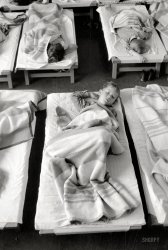
- The Dog-House: 1940
- ... format acetate negative by Marion Post Wolcott for the Farm Security Administration. View full size.
Don't bother looking on ... Posted by Dave - 09/23/2019 - 6:32pm -
![The Dog-House: 1940 1940. "New Orleans, Louisiana. Old building at Rampart and Bienville streets." Medium format acetate negative by Marion Post Wolcott for the Farm Security Administration. View full size.
Don't bother looking on Google street viewOne modern building and three parking lots
:-(
Take me somewhere special, driverThe cap pushed jauntily back on his head tells me the guy in the white shirt leaning against the corner is the driver of the Checker Cab at left. Everything else about him tells me he can take you places in New Orleans that are not included in the Chamber of Commerce list of local attractions.
Oh, that Marion Post Wolcott asked to go photograph such a place. Not for the smut, but for the depth she brought to her subjects.
[MPW didn't "ask to go" photograph this place. - Dave]
Sorry, I should have said: Oh, that Marion Post Wolcott had asked the driver to take her to such a place. Not for the smut or the violence, but for the depth she brought to her subjects.
["The driver" was MPW. - Dave]
From the 1938 WPA Guide to New OrleansDog House, 300 North Rampart St., is open from 9 P.M. until 4 A.M.
Both jazz orchestra and floor show are colored, and three performances are given nightly, 11 P.M., 1.30 and 3 A.M. A high-class place, says the proprietor, for middle class people, and one where they can have freedom of body and soul. The taxi girls bring their lunch.
Can't be 1940With that at least 1942 Chevrolet, already rough around the edges, lurking there on the left.
[The car is a 1941 Chevrolet, introduced in 1940; both cars have 1940 plates. - Dave]
Big Yellow TaxiDon't it always seem to go
That you don't know what you've got til its gone
They paved paradise
And put up a parking lot
A floor show at 3:30 AM? Wow. As a habitue of bars in my youth I remember bars and their customers at the usual closing time of 2 AM but 3:30 AM customers watching a floor show must have been a thing of beauty to behold to a people watcher and a pub crawler like me.
According to google View there are 3 parking lots at this corner so I'm going with the hope I called the shot of a parking lot where the Dog House stood.
(The Gallery, Eateries & Bars, M.P. Wolcott)](https://www.shorpy.com/files/images/SHORPY-8c14682a.thumbnail.jpg)
- Stop and Go: 1941
- ... Vermont." Medium format negative by Jack Delano for the Farm Security Administration. View full size.
Ford V8 passing a Chevy At ... Posted by Dave - 02/14/2019 - 2:43pm -
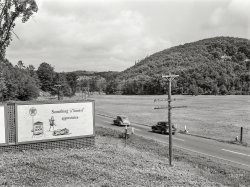
- Earth and Sky: 1938
- ... Medium-format safety negative by Edwin Rosskam for the Farm Security Administration.
Huffing, Puffing But this is just begging for a ... Posted by Dave - 03/05/2019 - 3:13pm -
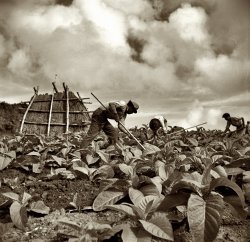
- A Sign Unto You: 1939
- ... format acetate negative by Marion Post Wolcott for the Farm Security Administration. View full size.
The end is near Especially ... Posted by Dave - 04/30/2019 - 3:25pm -
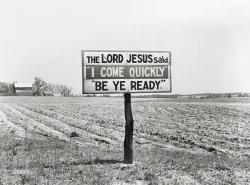
- Elko Tango: 1940
- ... Medium format negative by Arthur Rothstein for the Farm Security Administration. View full size.
Skipping Any old CB user is ... Posted by Dave - 01/31/2018 - 10:17pm -
